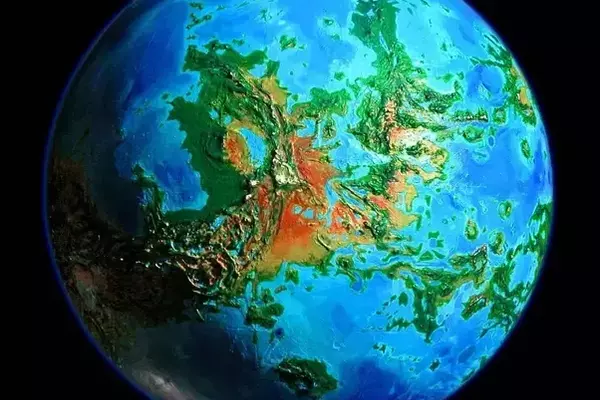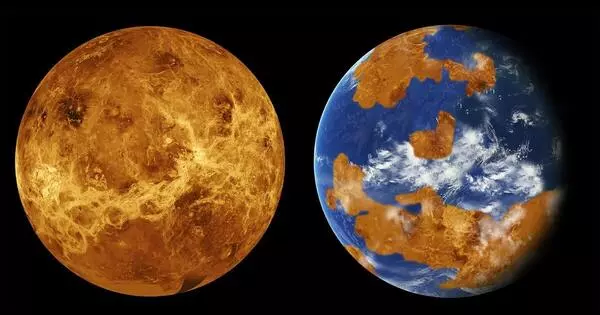Astrophysicists have investigated Venus’s past to determine whether the Earth’s sister planet once had oceans.
Venus can be thought of as Earth’s evil twin. At first glance, it has the same mass and size as our planet, is mostly made of rocky material, has some water, and has an atmosphere. However, a closer examination reveals significant differences between them: Venus’ thick CO2 atmosphere, extreme surface temperature, and pressure, and sulfuric acid clouds are all stark contrasts to the conditions required for life on Earth. This, however, may not have always been the case.
Previous research has suggested that Venus may have been a much more hospitable planet in the past, with its own liquid water oceans. A team of astrophysicists led by the University of Geneva (UNIGE) and the National Centre of Competence in Research (NCCR) PlanetS, Switzerland, investigated whether our planet’s twin had milder periods. The findings, published in the journal Nature, indicate that this is not the case.
Astrophysicists are increasingly interested in Venus. The European Space Agency and NASA decided this year to send at least three space exploration missions to the second closest planet to the Sun over the next decade. One of the key questions these missions aim to answer is whether or not Venus ever hosted early oceans. Astrophysicists led by Martin Turbet, researcher at the Department of Astronomy of the Faculty of Science of the UNIGE and member of the NCCR PlanetS, have tried to answer this question with the tools available on Earth.
Our results are based on theoretical models and are an important building block in answering the question of Venus’s history. But we won’t be able to make a final decision on our computers. The observations of the three future Venusian space missions will be critical in confirming or refuting our findings.
David Ehrenreich
“We simulated the climate of the Earth and Venus at the very beginning of their evolution, more than four billion years ago, when the surface of the planets was still molten,” explains Martin Turbet. “The associated high temperatures meant that any water would have been present in the form of steam, as in a gigantic pressure cooker.” Using sophisticated three-dimensional models of the atmosphere, similar to those scientists use to simulate the Earth’s current climate and future evolution, the team studied how the atmospheres of the two planets would evolve over time and whether oceans could form in the process.
“We were able to show that the climatic conditions did not allow water vapour to condense in the atmosphere of Venus,” says Martin Turbet. This means that the temperatures in its atmosphere were never low enough for raindrops to form and fall on its surface. Instead, water remained as a gas in the atmosphere, and oceans never formed.
“One of the main reasons for this is that clouds form preferentially on the planet’s night side. These clouds produce a powerful greenhouse effect, preventing Venus from cooling as quickly as previously thought” continues the Geneva researcher.

Small differences with serious consequences
Surprisingly, the astrophysicists’ simulations also reveal that the Earth could easily have suffered the same fate as Venus. If the Earth had been just a little closer to the Sun, or if the Sun had shone as brightly in its ‘youth’ as it does nowadays, our home planet would look very different today. It is likely the relatively weak radiation of the young Sun that allowed the Earth to cool down enough to condense the water that forms our oceans.
According to Emeline Bolmont, UNIGE professor, PlaneS member, and co-author of the study, “This is a complete reversal of what has long been known as the “Faint Young Sun paradox.” It has always been regarded as a major impediment to the appearance of life on Earth!” The argument was that if the Sun’s radiation had been much weaker than it is today, it would have turned the Earth into a hostile ball of ice. “However, it turns out that for the young, very hot Earth, this weak Sun may have actually been an unanticipated opportunity,” the researcher continues.
“Our results are based on theoretical models and are an important building block in answering the question of Venus’s history,” says study co-author David Ehrenreich, professor in the Department of Astronomy at UNIGE and member of the NCCR PlanetS. “But we won’t be able to make a final decision on our computers. The observations of the three future Venusian space missions will be critical in confirming or refuting our findings.”
These prospects excite Emeline Bolmont, who believes that “these fascinating questions can be addressed by the new Centre for Life in the Universe, which has just been established within the UNIGE’s Faculty of Science.”
















